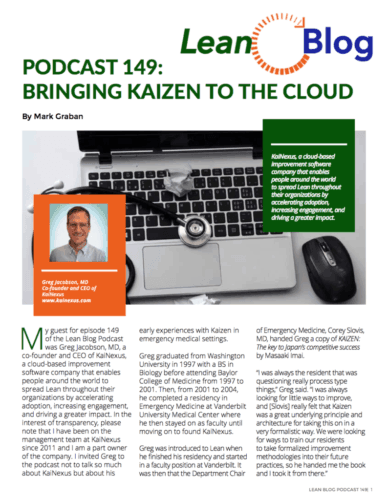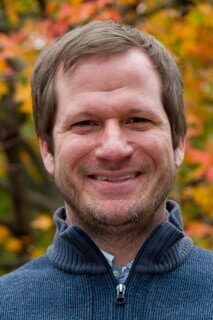Listen
My guest for episode #149 is Gregory Jacobson, MD, the co-founder and CEO at KaiNexus. We'll be talking about his early work with Kaizen in emergency medicine settings – how did he get introduced to Kaizen principles and how did train others, especially physicians, in getting started with this methodology?
In a future episode, we'll talk more about KaiNexus and use of software, but today's focus is on the application of core Kaizen principles (as discussed in my book Healthcare Kaizen).
For a link to this episode, refer people to www.leanblog.org/149.
Conflict of interest disclosure: I have been on the management team at KaiNexus since 2011 and I am a part owner of the company.
You can also read a summary of the podcast, which you can also download as:
- Low-res PDF (for reading on screen)
- High-res PDF (for printing)

For earlier episodes, visit the main Podcast page, which includes information on how to subscribe via RSS or via Apple Podcasts.
You can also listen via Stitcher.
Podcasts Sponsored by KaiNexus
If you have feedback on the podcast, or any questions for me or my guests, you can email me at leanpodcast@gmail.com or you can call and leave a voicemail by calling the “Lean Line” at (817) 993-0630 or contact me via Skype id “mgraban”. Please give your location and your first name. Any comments (email or voicemail) might be used in follow ups to the podcast.
What do you think? Please scroll down (or click) to post a comment. Or please share the post with your thoughts on LinkedIn – and follow me or connect with me there.
Did you like this post? Make sure you don't miss a post or podcast — Subscribe to get notified about posts via email daily or weekly.
Check out my latest book, The Mistakes That Make Us: Cultivating a Culture of Learning and Innovation:










Nice to have a physician’s viewpoint.
Greg’s comment that to engage physicians, improvements need to be quick and easy – they don’t want something that’s going to take much of their time – frustrates me. Not that I disagree or that I’m surprised. I see what he’s referring to almost daily and I’ve been beating my head against that wall a long time. Unfortunately, much, if not most kaizen is not the easy, silver bullet, quick fix that nearly everyone would like (in fact, it’s L.A.M.E.). Once in a while there is significant payoff for the small investment, but not often, and I would hesitate to try and initially engage a physician this way, knowing that once that physician started to truly understand lean thinking more deeply, he/she would then come to realize that it’s not so quick and easy after all, and that there is a lot to learn. In fact, the physician might feel bait and switched, even though that is not the intention.
This is a mountain I’ve been climbing almost daily for the past 6 years. The best way I know to get physicians on board – and even this method is not what I’d call hugely successful – is to rigorously and thoroughly follow A3 thinking (which incidentially, is the scientific method they use – it’s important to point that out to them so they understand that lean is legit and not just the latest flavor of the month), and let the docs see that we get good results with some blood and sweat. They’re particularly interested if we solve some of THEIR problems.
That’s been my experience. Perhaps others’ experiences vary from mine. Let’s hear them.
Thanks for listening and for your comment.
The reality is that if you want a doctor to stop for 15-30 min in the middle morning rounds, then you will likely continue to beat your head against the wall for another six years. The capturing of the moment or opportunity needs to be quick and easy. The implementation, evaluation problem solving can be done at a scheduled time in the future and can be longer, following the scientific method, like you suggest.
Also, a ton of kaizens ARE just quick and easy. Those quick and easy ones still come up at vandy after 6 yrs of doing this. An example, just 5 min ago an “Opportunity for Improvement” was completed that I put in this weekend at a hospital I work at in Austin (I got an email notification through KaiNexus).
I wanted erythromycin ophth ointment in the omnicell. We use it a lot. Nurses have to go get it from a different part of the hospital. It takes 10 min to walk there and a nurse gets taken out of the ED. Nurse will delay getting it until they have time. This often creates an extra 30-45 minutes for the patient. Erythro was added essentially next business day. Quick and easy. Capturing this took 1 min of my time and will save dozens of hours over the next year alone.
These little ideas do add up to make a big difference. We can work on the big stuff too.
I don’t think it’s a “bait and switch” at all to start with “quick and easy kaizen” small stuff and then move to big, more complex problems.
Small kaizen and big transformational change can (and must) co-exist. One doesn’t preclude the other. We can have little kaizen and big kaizen that all follows the PDCA/PDSA model and the scientific method.
I think it’s far easier to teach the kaizen mindset on small stuff… you can then move toward bigger improvements (and keep doing small kaizen, like Greg said).
Thanks for your responses, guys.
I don’t disagree that quick and easy kaizen is out there. Call it quick and easy kaizen, call it low hanging fruit, call it whatever you want. And, this is another good strategy you’re offering to help get docs on board. Thank you for that. Thing is, my experience has been that irregardless of whether it’s quick and easy kaizen or larger, longer projects, the odds of getting docs on board is slim. Greg – as a physician yourself, you carry some credibility with other docs. I’m sure you’ve seen some success with this, and that’s good. We “lowly lean coaches” stand significantly less of a chance.
I would imagine there are many others at least as frustrated, or even more frustrated than me on this issue, but again I credit you both for promoting another method. I’d have to say that just as so many docs I’ve observed not giving lean much of a chance, I equally feel that I’m wasting my time with the effort of trying to get them on board. Leave that to the C-level suite and other docs.
Perhaps I’ve grown cynical about this, and I apologize for that. Kudos to both of you for continuing to carry the torch. I hope you and the readership of leanblog.org have success getting more docs on board.
It’s dangerous to generalize, but docs generally tend to want to listen to other docs. There are, of course, exceptions. I think sometimes if you can find one or two key physician leaders who will learn from us Lean types, then they can carry the torch with others (as Greg and some of the physician leaders at VUMC did). I’ve met many MD leaders like this at many health systems. I guess it’s like finding a single person who is a key point of leverage in the organization. With a lever that’s long enough, we can move the world. I guess we need a fulcrum too… what’s the fulcrum in this analogy?